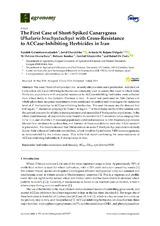The First Case of Short-Spiked Canarygrass (Phalaris brachystachys) with Cross-Resistance to ACCase-Inhibiting Herbicides in Iran
Autor
Golmohammadzadeh, Sajedeh
Gherekhloo, Javid
Rojano Delgado, Antonia M.
Osuna Ruiz, M.D.
Kamkar, Behnam
Ghaderi-Far, Farshid
Prado Amián, Rafael de
Editor
MDPIFecha
2019Materia
Herbicides resistanceSeed bioassay
EC50
GR50
Cytochrome P450
METS:
Mostrar el registro METSPREMIS:
Mostrar el registro PREMISMetadatos
Mostrar el registro completo del ítemResumen
The weed Phalaris brachystachys Link. severely affects winter cereal production. Acetyle-CoA Carboxylase (ACCase)-inhibiting herbicides are commonly used to control this weed in wheat fields. Thirty-six populations with suspected resistance to ACCase-inhibiting herbicides were collected from wheat fields in the Golestan Province in Iran. A rapid test performed in Petri dishes and whole-plant dose–response experiments were conducted to confirm and investigate the resistance level of P. brachystachys to ACCase-inhibiting herbicides. The seed bioassay results showed that 0.02 mg ai L−1 clodinafop-propargyl (CP) and 1.36 mg ai L−1 of the diclofop-methyl (DM) solution were the optimal amounts for reliably screening resistant and susceptible P. brachystachys populations. In the whole plant bioassay, all populations were found to be resistant to CP, resistance ratios ranging from 2.7 to 11.6, and all of the CP-resistant populations exhibited resistance to DM. Fourteen populations showed low resistance to cycloxydim, and thirteen of these populations were also 2-fold resistant to pinoxaden. The results showed that DM resistance in some P. brachystachys populations is likely due to their enhanced herbicide metabolism, which involves Cytochrome P450 monooxygenases, as demonstrated by the indirect assay. This is the first report confirming the cross-resistance of ACCase-inhibiting herbicides in P. brachystachys in Iran.

